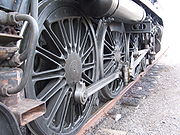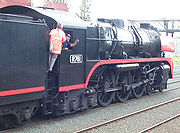
SCOA-P wheel
Encyclopedia


Steam locomotive
A steam locomotive is a railway locomotive that produces its power through a steam engine. These locomotives are fueled by burning some combustible material, usually coal, wood or oil, to produce steam in a boiler, which drives the steam engine...
wheel
Wheel
A wheel is a device that allows heavy objects to be moved easily through rotating on an axle through its center, facilitating movement or transportation while supporting a load, or performing labor in machines. Common examples found in transport applications. A wheel, together with an axle,...
. Rather than having traditional solid spoke
Spoke
A spoke is one of some number of rods radiating from the center of a wheel , connecting the hub with the round traction surface....
s, the SCOA-P spoke is hollow, with a 'U' shaped cross section. They are considerably lighter than a conventional spoked wheel or Boxpok
Boxpok
A Boxpok is a steam locomotive wheel that gains its strength through being made of a number of box sections rather than having traditional solid spokes . Being hollow, they allow better counterbalancing than conventional drivers, which is important for fast locomotives...
wheel of the same size and strength.
History
SCOA-P wheels were developed in the late 1940s by the Steel Company of Australia Ltd (the P in the acronym standing for F. C. Paynter, who patented the design) in response to Victorian RailwaysVictorian Railways
The Victorian Railways operated railways in the Australian state of Victoria from 1859 to 1983. The first railways in Victoria were private companies, but when these companies failed or defaulted, the Victorian Railways was established to take over their operations...
experiencing fatigue problems with conventional spoked wheels. Stronger Boxpok type 'B' wheels had been installed on a number of VR locomotive classes in the late 1940s, but they had the disadvantage of being relatively heavy and also restricted maintenance access to axleboxes, underslung springs, and in some cases boiler washout plugs. Boxpok wheels were proposed for the forthcoming Victorian Railways R class
Victorian Railways R class
The R class was an express passenger steam locomotive that ran on Australia's Victorian Railways from 1951 to 1974. A long overdue replacement for the 1907-era A2 class 4-6-0, their development and construction was repeatedly delayed due to financial constraints caused by the Great Depression and...
4-6-4
4-6-4
Under the Whyte notation for the classification of steam locomotives, 4-6-4 represents the wheel arrangement of four leading wheels on two axles , six powered and coupled driving wheels on three axles, and four trailing wheels on two axles .Other equivalent classifications are:UIC classification:...
, which had a relatively heavy 19.5 long ton
Long ton
Long ton is the name for the unit called the "ton" in the avoirdupois or Imperial system of measurements, as used in the United Kingdom and several other Commonwealth countries. It has been mostly replaced by the tonne, and in the United States by the short ton...
axle load, but it had been discovered that the use of a Boxpok wheel would make coupling rod
Coupling rod
right|thumb|connecting rod and coupling rods attached to a small locomotive driving wheelA coupling rod or side rod connects the driving wheels of a locomotive. Steam locomotives in particular usually have them, but some diesel and electric locomotives, especially older ones and shunters, also have...
pin removal difficult. The SCOA-P wheel was developed to allow the strength of the Boxpok design but also provide the maintenance access of a conventional spoked wheel.
Comparative performance
The SCOA-P wheel centre of a 73 inch R class driving wheelDriving wheel
On a steam locomotive, a driving wheel is a powered wheel which is driven by the locomotive's pistons...
weighed only 1,829 lb
Pound (mass)
The pound or pound-mass is a unit of mass used in the Imperial, United States customary and other systems of measurement...
, 322 lb lighter than a Boxpok design of the same diameter and equivalent strength. Using a 100-ton vertical press, load testing was conducted of the strength and elasticity of the SCOA-P wheel centre against a 2,021 lb conventional spoked driving wheel centre of an A2 class
Victorian Railways A2 class
The A2 class was an express passenger locomotive that ran on Victorian Railways from 1907 to 1963. A highly successful design entirely the work of Victorian Railways' own design office, its long service life was repeatedly extended as economic depression and war delayed the introduction of more...
locomotive that had the same diameter, but was engineered for a lower 17.5 ton axle load
Axle load
The axle load of a wheeled vehicle is the total weight felt by the roadway for all wheels connected to a given axle. Viewed another way, it is the fraction of total vehicle weight resting on a given axle...
). The tests revealed that the SCOA-P wheel was still elastic at 23.4 long tons, with a permanent set occurring at about 30 tons, whereas the conventional spoked wheel experienced permanent set at 20 tons.
Use

Victorian Railways R class
The R class was an express passenger steam locomotive that ran on Australia's Victorian Railways from 1951 to 1974. A long overdue replacement for the 1907-era A2 class 4-6-0, their development and construction was repeatedly delayed due to financial constraints caused by the Great Depression and...
4-6-4
4-6-4
Under the Whyte notation for the classification of steam locomotives, 4-6-4 represents the wheel arrangement of four leading wheels on two axles , six powered and coupled driving wheels on three axles, and four trailing wheels on two axles .Other equivalent classifications are:UIC classification:...
and J class
Victorian Railways J class
The J class was a branch line steam locomotive that ran on Victorian Railways from 1954 to 1972. A development of the successful Victorian Railways K class 2-8-0, it was the last new class of steam locomotive introduced on the VR...
2-8-0
2-8-0
Under the Whyte notation for the classification of steam locomotives, 2-8-0 represents the wheel arrangement of two leading wheels on one axle , eight powered and coupled driving wheels on four axles, and no trailing wheels...
locomotives, introduced in 1951 and 1954 respectively. They were also used on the Queensland Rail
Queensland Rail
Queensland Rail, also known as QR, is a government-owned railway operator in the state of Queensland. Under the control of the Queensland Government, Queensland Rail operates the inner-city and long-distance passenger services, as well as some freight operations and gives railway access to other...
ways BB18¼ class 4-6-2
4-6-2
4-6-2, in the Whyte notation for the classification of steam locomotives, represents the wheel arrangement of four leading wheels on two axles , six powered and coupled driving wheels on three axles, and two trailing wheels on one axle .These locomotives are also known as Pacifics...
and Tasmanian Government Railways
Tasmanian Government Railways
The Tasmanian Government Railways was the former Government of Tasmania managed operator of mainline railways in Tasmania, Australia...
M class 4-6-2
4-6-2
4-6-2, in the Whyte notation for the classification of steam locomotives, represents the wheel arrangement of four leading wheels on two axles , six powered and coupled driving wheels on three axles, and two trailing wheels on one axle .These locomotives are also known as Pacifics...
and H class 4-8-2
4-8-2
Under the Whyte notation for the classification of steam locomotives, 4-8-2 represents the wheel arrangement of four leading wheels on two axles , eight powered and coupled driving wheels on four axles, and two trailing wheels on one axle...
.
Because the Vulcan Foundry
Vulcan Foundry
Vulcan Foundry was a British locomotive builder sited at Newton-le-Willows, Lancashire .-History:It was originally opened in 1832 as Charles Tayleur and Company to produce girders for bridges, switches and crossings, and other ironwork following the opening of the Liverpool and Manchester Railway...
, which built the VR J class, built SCOA-P wheeled locomotives for export until ceasing steam locomotive production in 1956, this wheel type was also seen in many of Vulcan's other export markets.
SCOA-P wheel centres were found on locomotives for the Gold Coast Railway in Africa (WM and YL classes), East African Railways (30Nairobi Railway Museum - 3020 Nyaturu - retrieved 30 October 2006 and 31Nairobi Railway Museum - 3123 Bavuma - retrieved 30 October 2006 classes), Iran Railways' 2-10-2
2-10-2
Under the Whyte notation for the classification of steam locomotives, 2-10-2 represents the wheel arrangement of two leading wheels on one axle, usually in a leading truck, ten powered and coupled driving wheels on five axles, and two trailing wheels on one axle, usually in a trailing truck...
Decapod,Vulcan Foundry Locomotive List - Iranian Decapod - retrieved 30 October 2006 and a class of Indian Government Railways' 2-8-4
2-8-4
In the Whyte notation, a 2-8-4 is a railroad steam locomotive that has one unpowered leading axle followed by four powered driving axles and two unpowered trailing axles. This locomotive type is most often referred to as a Berkshire, though the Chesapeake and Ohio Railway used the name Kanawha for...
T tank locomotives, among others.

